
Photos: Top Shooters & Award Winners
March 26, 2019
By Geoff Kimmerly
Second Half editor
The MHSAA Girls & Boys Basketball Finals the last two weekends showed off many of the best teams and players who took the courts across Michigan this winter.
The championships also provided an opportunity to celebrate a few more accomplishments with the Basketball Coaches Association of Michigan “Top Shooters Challenge” contests and MHSAA recognition for leaders past, present and future.
Below are photos from a number of events that took place during quarter breaks and halftimes at Van Noord Arena this past weekend and the Breslin Center two weeks ago.
Top Shooters: This season’s BCAM top shooters contests again recognized the sharpest from the free-throw line and 3-point arc. This past weekend at Calvin College, Grand Rapids Forest Hills Northern’s Madi Stevenson won the 3-point contest with Pontiac Notre Dame Prep’s Sarah Stuart runner-up, while Saline’s Ella Stemmer won the free throw contest and Manton’s Abby Brown was second.
At Breslin, Mio’s Drew Hess won the 3-point challenge with Kent City’s Eli Carlson second. Zeeland East’s Clayton Dykhouse and Owosso’s Carson Bornefeld tied for the free throw championship.
(See photo above, clockwise from left: Girls free throw finalists, boys free throw finalists, girls 3-point finalists and boys 3-point finalists.)
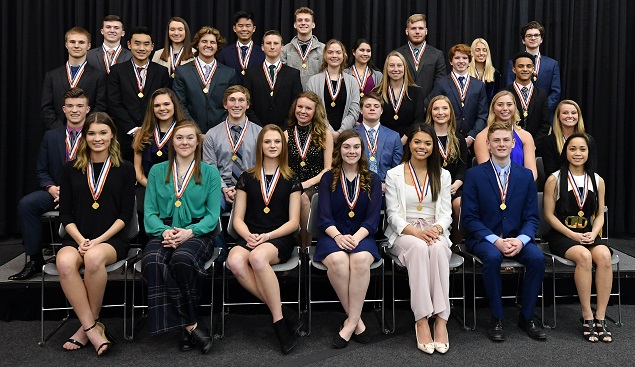
30th Scholar-Athlete Awards: Farm Bureau and the MHSAA presented 31 honorees with Scholar-Athlete Awards during Boys Finals weekend (one honoree was unable to attend). This year’s selections were honored at a banquet and then on the floor during halftime of the Division 3 Final.
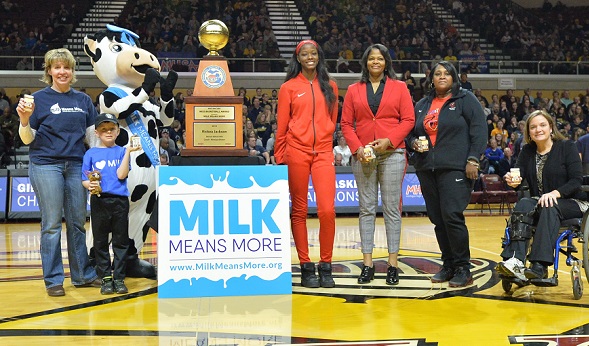
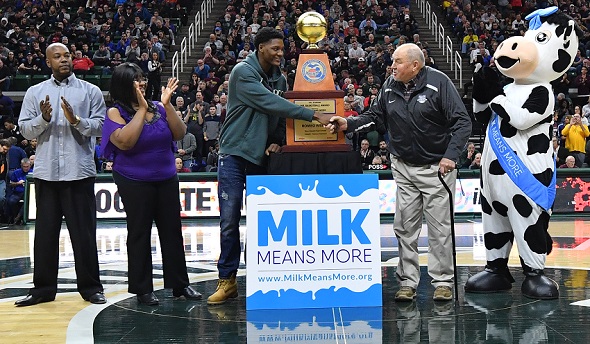
Miss Basketball & Mr. Basketball: Detroit Edison’s Rickea Jackson was recognized on-court as the Miss Basketball Award winner during Saturday’s Division 3 game before leading the Pioneers that evening to their third straight MHSAA title. Mr. Basketball Award honoree Romeo Weems accepted the trophy at Breslin as this year’s top senior on the boys side.
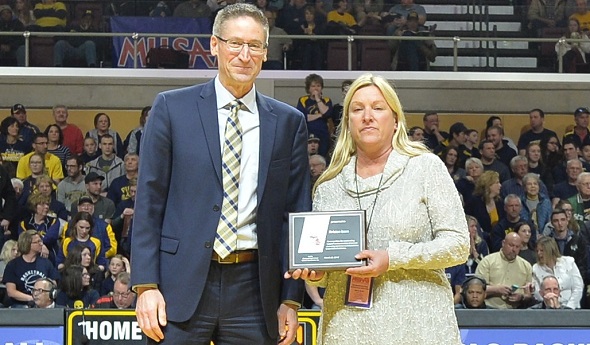
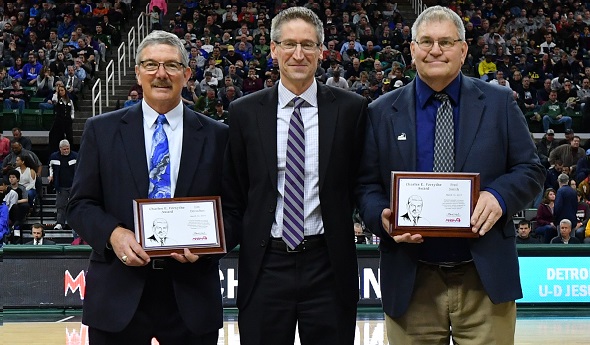
WISL & Forsythe Awards: Adrian Madison athletic director Kris Isom was honored Saturday as this year’s recipient of the MHSAA Women In Sports Leadership Award. The week prior, retired Negaunee and Brimley superintendent Jim Derocher and retired Buchanan, Benton Harbor, Comstock and St. Joseph Lake Michigan Catholic athletic director Fred Smith accepted Charles E. Forsythe Awards. All three were presented by Grand Haven Area Public Schools assistant superintendent Scott Grimes, who serves as president of the MHSAA’s Representative Council.
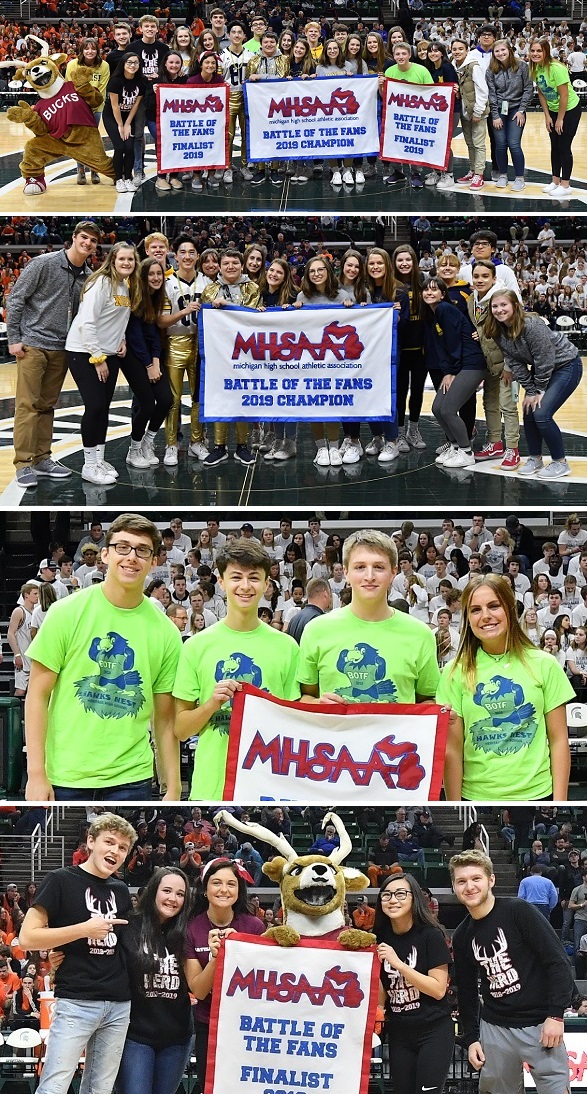
Battle of the Fans: Representatives from all three finalists from this year’s BOTF VIII – champion North Muskegon with Saginaw Heritage and Buchanan – took to the Breslin floor during the Division 2 Semifinals to receive their banners.
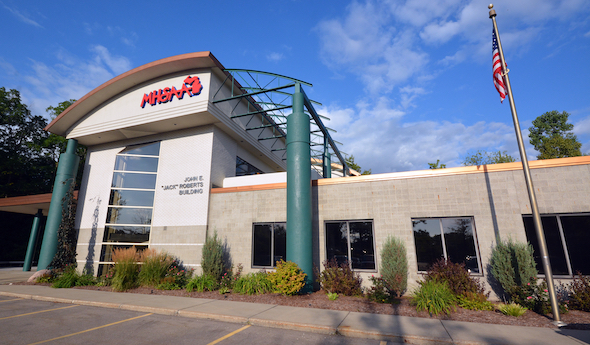
From the Director: Back to School
August 7, 2020
By Mark Uyl
MHSAA Executive Director
Since March 12, our world has been anything but normal. These times have tested most everything in life, and as summer turns toward fall, we find ourselves still with far more questions than answers. It has been said that an abnormal reaction to an abnormal situation is normal behavior.
Let me start with these abnormal times. I’ve had many conversations with administrators over the past month about the start of school and school sports. The one constant theme is these are anything but normal times. Many of these conversations have moved to the issue of schools starting the academic year virtually while considering whether or not to offer school sports opportunities this fall. Let me share the things that have been part of almost all conversations on this topic.
The loudest message I hear is kids are going to be playing sports this fall someplace. Period. If we believe that kids are going to take the fall off if school sports aren’t offered, we haven’t been paying much attention since May. Since that time, athletic activity has taken place in the club, travel, AAU and non-school space nearly every day. From first-hand experience, many of these events have implemented ZERO of the safety standards and protocols that businesses and schools have adopted for their plans of return. The non-school world generally has plowed ahead this summer with few-to-no rules, regulations, enforcement, oversight and accountability to anyone. If kids are going to be playing sports, our member schools are telling us that activity needs to be in the safest environment possible – which is with professional educators and trained coaches in our school sports world.
Schools are quick to point out that kids have been conditioning and training with school coaches in school-sponsored workouts most of the summer. We believe that the absence of virus outbreaks among our 749 high schools’ summer activities, involving thousands of kids, has been because schools have been following the return-to-activity plans. Districts have told us they can continue doing what they’ve been doing safely since June by following all COVID guidance and regulations we have put in place with government’s leadership and partnership.
Schools starting the year virtually are telling us they will use the lessons learned from the start of sports for when students return to campus later in the fall. School administrators have shared this view privately as this has become a highly-charged topic among various groups within our school communities. Sports allow schools to bring students back to campus in small, consistent and defined groups with the same adults working with those students each day. In school sports, there is little mixing of students from one sport with those students in another – making it much easier to monitor, track and trace kids when needed than if all students were in the buildings, hallways and classrooms all day. We hear from administrators that valuable lessons can be learned with athletics in August and September for a successful school start-up with students back on campus in October.
All of us share the fundamental belief that we must protect the health and safety of individuals first. This doesn’t include only COVID prevention measures, but also the mental health of teenage students and adults as well. In districts that are starting the school year online, they see athletics being the one shred of normalcy students, and staff members who choose to coach, will have during the fall. It’s a chance to safely interact with peers and get needed physical activity that hasn’t been happening for some kids since March. Health and safety has to include all facets of the individual, and more research is being shared each day about how mental health is becoming a critical issue. For many at-risk kids, sports is the one motivating factor to keep them in school and progressing toward graduation. Given the challenges of all online education for these at-risk kids, sports and the daily routine they bring perhaps would be more important for this group of students than ever before.
With no school sports, the affluent communities and families can navigate online learning during the day and then afford the non-school athletic opportunities that kids and families in less-affluent areas simply cannot. In many communities, school sports can provide opportunities and open doors that would not appear if kids become priced-out from participating and competing.
The past five months have been the most abnormal in a century. School sports being the one pathway back to school for students in our state – the one norm for this fall – run by professional educators who put kids first, would be an incredible boost to the physical and mental health of all of us. We believe that school sports can be done safely and smartly, and the MHSAA has developed plans that do just that. While the optics of sports taking place while waiting for in-person education is not what any of us prefer, we believe we must react to these abnormal times by thinking differently and looking at these unique times through a unique lens.
Trying to find one normal for our kids in these abnormal school days might just be the best thing we can do.

